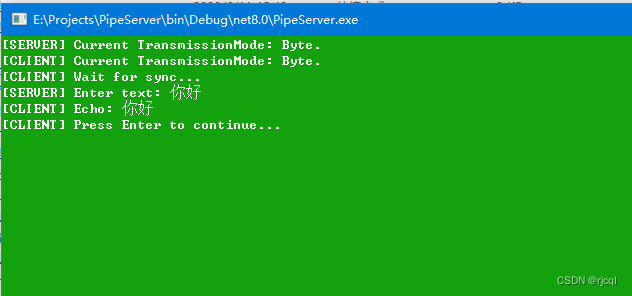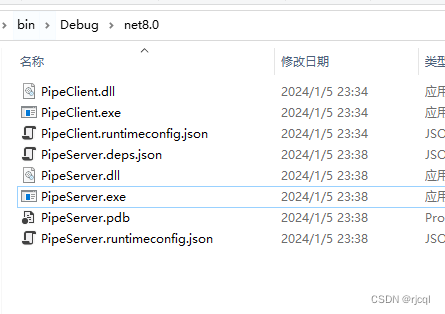C# 使用匿名管道进行本地进程间通信
发布时间:2024年01月06日
目录
写在前面
相对于命名管道通讯方式而言,匿名管道开销更小,更轻松便捷;缺点就是无法进行网络通讯,只能在本机使用,应用场景相对狭窄;适合于本地多进程之间的通讯,比如主节点和多个从节点之间的交互。
以下代码实现主要来自微软官网,实现了采用匿名管道将字符串从父进程发送到子进程的功能。
代码实现
客户端进程
using System;
using System.IO;
using System.IO.Pipes;
class PipeClient
{
static void Main(string[] args)
{
if (args.Length > 0)
{
// 指定为接收端: PipeDirection.In
using PipeStream pipeClient = new AnonymousPipeClientStream(PipeDirection.In, args[0]);
Console.WriteLine("[CLIENT] Current TransmissionMode: {0}.", pipeClient.TransmissionMode);
using (StreamReader sr = new StreamReader(pipeClient))
{
// Display the read text to the console
string temp;
// Wait for 'sync message' from the server.
do
{
Console.WriteLine("[CLIENT] Wait for sync...");
temp = sr.ReadLine();
}
while (!temp.StartsWith("SYNC"));
// Read the server data and echo to the console.
while ((temp = sr.ReadLine()) != null)
{
Console.WriteLine("[CLIENT] Echo: " + temp);
}
}
}
Console.Write("[CLIENT] Press Enter to continue...");
Console.ReadLine();
}
}服务端进程
using System;
using System.IO;
using System.IO.Pipes;
using System.Diagnostics;
class PipeServer
{
static void Main()
{
Process pipeClient = new Process();
pipeClient.StartInfo.FileName = "pipeClient.exe";
// 指定为发送端:PipeDirection.Out
using AnonymousPipeServerStream pipeServer = new AnonymousPipeServerStream(PipeDirection.Out, HandleInheritability.Inheritable);
Console.WriteLine("[SERVER] Current TransmissionMode: {0}.", pipeServer.TransmissionMode);
// Pass the client process a handle to the server.
pipeClient.StartInfo.Arguments = pipeServer.GetClientHandleAsString();
pipeClient.StartInfo.UseShellExecute = false;
pipeClient.Start();
pipeServer.DisposeLocalCopyOfClientHandle();
try
{
// Read user input and send that to the client process.
using (StreamWriter sw = new StreamWriter(pipeServer))
{
sw.AutoFlush = true;
// Send a 'sync message' and wait for client to receive it.
sw.WriteLine("SYNC");
pipeServer.WaitForPipeDrain();
// Send the console input to the client process.
Console.Write("[SERVER] Enter text: ");
sw.WriteLine(Console.ReadLine());
}
}
// Catch the IOException that is raised if the pipe is broken
// or disconnected.
catch (IOException e)
{
Console.WriteLine("[SERVER] Error: {0}", e.Message);
}
pipeClient.WaitForExit();
pipeClient.Close();
Console.WriteLine("[SERVER] Client quit. Server terminating.");
Console.ReadLine();
}
}调用示例

?

?需要注意的是除了客户端的exe和dll,配置文件PipeClient.runtimeconfig.json也需要一并放入服务端的运行目录。
文章来源:https://blog.csdn.net/rjcql/article/details/135419841
本文来自互联网用户投稿,该文观点仅代表作者本人,不代表本站立场。本站仅提供信息存储空间服务,不拥有所有权,不承担相关法律责任。 如若内容造成侵权/违法违规/事实不符,请联系我的编程经验分享网邮箱:chenni525@qq.com进行投诉反馈,一经查实,立即删除!
本文来自互联网用户投稿,该文观点仅代表作者本人,不代表本站立场。本站仅提供信息存储空间服务,不拥有所有权,不承担相关法律责任。 如若内容造成侵权/违法违规/事实不符,请联系我的编程经验分享网邮箱:chenni525@qq.com进行投诉反馈,一经查实,立即删除!
最新文章
- Python教程
- 深入理解 MySQL 中的 HAVING 关键字和聚合函数
- Qt之QChar编码(1)
- MyBatis入门基础篇
- 用Python脚本实现FFmpeg批量转换
- 【web安全】登录界面渗透的思路总结
- 百度网盘网页无法调起客户端 目前未解决 2024年1月出现BUG
- C波段数据链和DAA技术实现BVLOS超视距飞行-乔克托族BEYOND计划获得FAA扩大批准
- 【Stm32-F407】Keil uVision5 下新建工程
- 【运维面试100问】(十二)你对nginx做过哪些优化?
- Springboot使用log4j2日志框架
- 什么是CSS3?深入理解css3
- 代码随想录算法训练营第十天|232.用栈实现队列、225. 用队列实现栈
- 25计算机专业考研经验贴之准备篇
- Cyber RT 话题通信